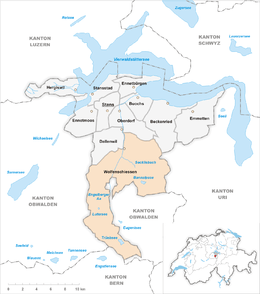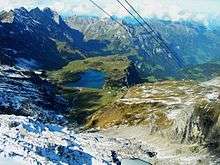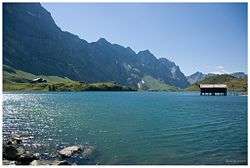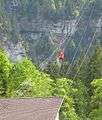Wolfenschiessen
| Wolfenschiessen | ||
|---|---|---|
 | ||
| ||
 Wolfenschiessen | ||
|
Location of Wolfenschiessen  | ||
| Coordinates: 46°54′N 8°23′E / 46.900°N 8.383°ECoordinates: 46°54′N 8°23′E / 46.900°N 8.383°E | ||
| Country | Switzerland | |
| Canton | Nidwalden | |
| District | n.a. | |
| Area[1] | ||
| • Total | 92.77 km2 (35.82 sq mi) | |
| Elevation (Wolfenschiessen village) | 510 m (1,670 ft) | |
| Highest elevation (Titlis Glacier) | 2,880 m (9,450 ft) | |
| Lowest elevation (Niederrickenbach Station) | 488 m (1,601 ft) | |
| Population (Dec 2015[2]) | ||
| • Total | 2,148 | |
| • Density | 23/km2 (60/sq mi) | |
| Postal code | 6386 | |
| SFOS number | 1511 | |
| Surrounded by | Beckenried, Dallenwil, Engelberg (OW), Innertkirchen (BE), Isenthal (UR), Kerns (OW), Oberdorf | |
| Website |
www SFSO statistics | |
Wolfenschiessen is a village and municipality in the canton of Nidwalden in Switzerland. Besides the village of Wolfenschiessen itself, the municipality includes the settlements of Altzellen, Büren ob dem Bach, Dörfli and Oberrickenbach, together with a large area of high alpine land, mountains, lakes and glaciers.[3]
History
Wolfenschiessen was first mentioned around 1200 as ‘’Wolvinscizin’’[4] though a 14th century copy of a land record from around 1160 mentions two fields at ‘’Wolfenschiessen’’.[5] During the 12th century the farm and fields of Wolfenschiessen were owned by the Benedictine Muri Abbey. In the 13th and 14th centuries the lands were gradually transferred to Murbach-Lucerne and Engelberg Abbeys. Between the 12th and 13th centuries, the von Wolfenschiessen family were, probably, raised from farming to minor nobility and appointed to administer the monastery’s estates at Wolfenschiessen. They built a tower in the center of the village from which they administered and ruled over the village and farms. The family eventually grew to local prominence, before losing most of their wealth and status in the 15th century and dying out at the beginning of the 17th century.[6]
A village church was built by 1277 but was initially a filial church of the parish church in Stans. The village received its own priest in 1438 and in 1469 became an independent parish. During the 14th through 16th centuries several other hamlets developed around Wolfenschiessen.[4]
Coat of arms
The municipality's coat of arms is Azure, a Wolf rampant Argent pierced by an Arrow in bend sinister Or. This is an example of canting where the name of the municipality is translated or represented on the coat of arms. In this case, Wolfenschiessen means "to shoot the wolf."[7]
Geography


Wolfenshiessen encompasses both sides of the deep valley of the Engelberger Aa river downstream of Engelberg, with high alpine areas encircling Engelberg to the north, west and south. The settlements of Wolfenschiessen, Büren ob dem Bach and Dörfli lie in the valley, whilst Altzellen and Oberrickenbach are on higher ground to the east.[3]
The Bannalpsee lake lies above Oberrickenbach to the north of Engelberg, while the Trübsee is on high ground to the south of Engelberg. The southernmost part of the municipality reaches high up the flank of Mount Titlis, including part of the Titlis Glacier (Titlisgletscher).[3]
Wolfenschiessen has an area, as of 2006, of 92.8 km2 (35.8 sq mi). Of this area, 40.8% is used for agricultural purposes, while 33% is forested. Of the rest of the land, 1.2% is settled (buildings or roads) and the remainder (24.9%) is non-productive (rivers, glaciers or mountains).[8]
Demographics
Wolfenschiessen has a population (as of 31 December 2015) of 2,148.[9] As of 2007, 9.7% of the population was made up of foreign nationals.[10] Over the last 10 years the population has grown at a rate of 0.3%. Most of the population (as of 2000) speaks German (93.6%), with Albanian being second most common ( 2.7%) and Serbo-Croatian being third ( 1.4%).[8] As of 2008 the gender distribution of the population was 51.7% male and 48.3% female.
As of 2000 there are 674 households, of which 348 households (or about 51.6%) contain only one or two individuals. 111 or about 16.5% are large households, with at least five members.[11]
In the 2007 federal election the most popular party was the FDP which received 89.3% of the vote. The next two most popular parties were the local, small right-wing parties (10.7%) and the SPS (0.1%).[8]
In Wolfenschiessen about 58.6% of the population (between age 25-64) have completed either non-mandatory upper secondary education or additional higher education (either university or a Fachhochschule).[8]
Wolfenschiessen has an unemployment rate of 0.88%. As of 2005, there were 228 people employed in the primary economic sector and about 94 businesses involved in this sector. 138 people are employed in the secondary sector and there are 26 businesses in this sector. 268 people are employed in the tertiary sector, with 61 businesses in this sector.[8]
The historical population is given in the following table:[11][4]
| year | population |
|---|---|
| 1850 | 1,301 |
| 1900 | 1,096 |
| 1950 | 1,540 |
| 1960 | 1,647 |
| 1970 | 1,470 |
| 1980 | 1,524 |
| 1990 | 1,765 |
| 2000 | 2,041 |
| 2005 | 1,999 |
Transport
The municipality of Wolfenschiessen is served by two railway stations on the Luzern–Stans–Engelberg line. Besides Wolfenschiessen station itself, there is Niederrickenbach station, a request stop, to the north. The former Dörfli station to the south was closed in 2013. The hourly InterRegio service between Luzern and Engelberg stops at both stations, while the half hourly S4 service from Luzern terminates at Wolfenschiessen.[12]
A post bus service within the municipality links the villages of Wolfenschiessen and Oberrickenbach, with eight services per day. From Oberrickenbach, a cable car provides access to the Bannalpsee.[3][13] Many other cable cars provide access to higher dwellings, farms and tourist destinations on both sides of the valley.
The Trübsee lake is an intermediate stop on the cable car system that links Engelberg and the summit of Mount Titlis.[3]
Sights
The main sights of Wolfenschiessen are the St. Maria parish church, the St. Joder chapel in Altzellen, and the Hechhuis and Grossitz mansions.
Gallery
 Trübsee in summer
Trübsee in summer Cable car from Oberrickenbach up to the Bannalpsee
Cable car from Oberrickenbach up to the Bannalpsee The Pfarrkirche Maria Geburt church
The Pfarrkirche Maria Geburt church The Hechhuis mansion
The Hechhuis mansion- The Grossitz farmhouse
References
- ↑ Arealstatistik Standard - Gemeindedaten nach 4 Hauptbereichen
- ↑ Swiss Federal Statistical Office - STAT-TAB, online database – Ständige und nichtständige Wohnbevölkerung nach institutionellen Gliederungen, Geburtsort und Staatsangehörigkeit (German) accessed 30 August 2016
- 1 2 3 4 5 map.geo.admin.ch (Map). Swiss Confederation. Retrieved 2013-01-08.
- 1 2 3 Wolfenschiessen in German, French and Italian in the online Historical Dictionary of Switzerland.
- ↑ ortsnamen.ch retrieved 7 January 2016
- ↑ Wolfenschiessen, von in German, French and Italian in the online Historical Dictionary of Switzerland.
- ↑ Flags of the World-Wolfenschiessen accessed 4 September 2009
- 1 2 3 4 5 Swiss Federal Statistical Office accessed 04-Sep-2009
- ↑ Swiss Federal Statistical Office - STAT-TAB, online database – Ständige und nichtständige Wohnbevölkerung nach institutionellen Gliederungen, Geburtsort und Staatsangehörigkeit (German) accessed 30 August 2016
- ↑ Nidwalden Statistical Office-Population (German) accessed 4 September 2009
- 1 2 Nidwalden Statistical Office-Municipalities (German) accessed 4 September 2009
- ↑ "Luzern–Stans–Engelberg" (PDF). Bundesamt für Verkehr. Retrieved 2013-01-14.
- ↑ "Wolfenschiessen–Oberrickenbach (Linie 331)" (PDF). Bundesamt für Verkehr. Retrieved 2013-01-22.
| Wikimedia Commons has media related to Wolfenschiessen. |
